Smart Farming: Revolutionizing Agriculture with Technology
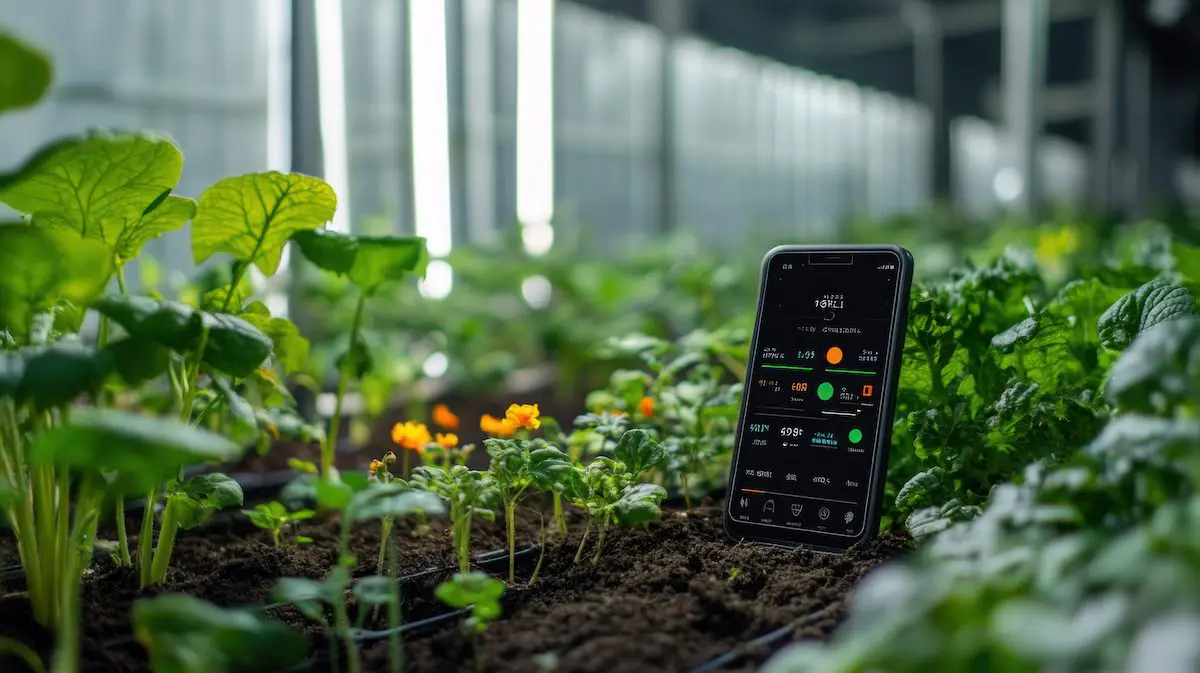
Do you face obstacles in keeping up with the rising costs of farming while maintaining profitability? That’s nothing surprising, considering the 8.9% drop in net income for US farms in 2024 compared to 2023. Add to that increasingly severe weather that destroys crops and disrupts planting schedules, and less-than-reliable international logistics, and we have a hurricane of challenges that farmers will have to contend with to stay afloat. It looks like without new, more sustainable strategies, it would be hard to overcome the obstacles. And there is a solution – smart farming.
Smart farming technology may help optimize production, reduce resource wastage, increase resilience in the face of unpredictable weather, and even root out world hunger. Since agriculture software development is one of our main focus areas, we can safely say that a smart approach to agriculture backed by the right technologies has undeniable benefits for agribusinesses. At a minimum, it’s worth taking a closer look at this practice of agricultural production.
What is Smart Farming?
There are a lot of “smart” things nowadays—smart refrigerators, smart thermostats, smart watches, smart doorbells, etc. When we speak about smart devices, we mean that they use a number of powerful technologies to learn from user behavior and make life more convenient. But how does it apply to agriculture, and what is smart farming?
The main idea of smart farming is the same – the use of modern technologies to manage a farm and improve every aspect of crop cultivation and the overall sustainability of agricultural operations. It’s like farming on autopilot, where you’re still in control but armed with all the data and insights you could ever need to increase the quality and quantity of your yield.
| Traditional Farming | Smart Farming | |
| Resource Management | Manual, often based on experience or guesswork. | Data-driven decisions based on real-time inputs from IoT sensors. |
| Water Usage | Irrigation is usually uniform across entire fields, leading to over or under-watering. | Smart irrigation systems apply water only where and when needed, conserving resources. |
| Pesticide/Fertilizer Use | Blanket application, leading to waste and potential environmental harm. | Precision application based on crop needs, reducing waste and environmental impact. |
| Crop Monitoring | Physical field checks, often labor-intensive and time-consuming. | Use of drones, sensors, and aerial imagery to monitor crops remotely and efficiently. |
| Decision-Making | Based on the farmer’s experience and historical knowledge. | Automated and data-driven decisions based on AI, predictive analytics, and machine learning. |
| Labor | High reliance on manual labor for planting, weeding, and harvesting. | Use of automation and robotics for tasks like planting, weeding, and harvesting, reducing labor costs. |
| Productivity | Varies, often dependent on weather conditions and other unpredictable factors. | Optimized yields through precise resource management and predictive analytics. |
| Environmental Impact | High due to overuse of resources and reliance on heavy machinery. | Lower impact due to resource efficiency, reduced emissions, and better land management. |
| Cost Efficiency | Costs fluctuate with inefficient resource use and manual labor. | Costs are optimized with reduced waste, better resource allocation, and automation. |
| Technology | Limited use of technology, mostly traditional tools and methods. | Heavy use of advanced technologies such as IoT, AI, drones, and big data analytics. |
You may think that it’s just another big tech solution for large agricultural companies. Yet, first, small private farms can also afford to implement a smart farming system thanks to the wider spread of mobile devices and IoT. Second, the adoption of technology for farming is no longer a luxury but rather a necessity driven by urgent concerns to reduce environmental impact and meet the growing demand for food. According to HSBS global research, food production must increase by more than 40% between now and 2040.
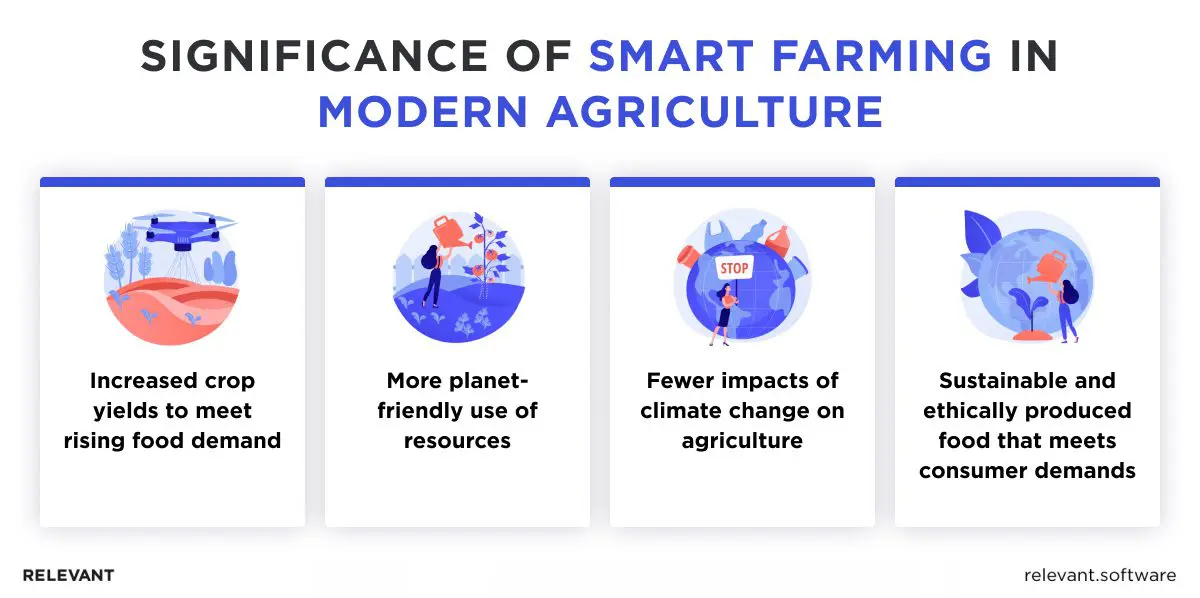
The significance of smart farming technologies lies in the fact that they help solve very real problems, from global issues to the day-to-day challenges of small and big farms. With their support, you can get more from your land without draining your budget or hurting the environment. Is unpredictable weather turning your planting schedules into a guessing game? Data-driven tools can help you fix that.
The Evolution of Farming: From Traditional to Smart
Farming has come a long way—literally. In the early days, farming meant nothing more than a person, a plot of land, and maybe an ox if you were lucky. Back then, farming was all about manual labor and the rhythm of nature, with farmers relying on their instincts, experience, and a little bit of luck. The invention of the plow was a turning point. Suddenly, there was an easier way to till the soil, and with that came a shift toward more organized and productive agricultural practices.
The Industrial Revolution in the 19th century brought even greater advancements. Tractors and harvesters replaced human hands, which sped up planting and harvesting while making the process more efficient. Growers also began to use fertilizers and pesticides to boost yields. Farms grew bigger, and farming started to look less like a family affair and more like a full-scale business.
One more paradigm shift the agriculture sector experienced in the digital age where technology and data rule the game. The digitalization has given rise to smart agriculture. What exactly is different about the smart way of farming? It’s all about precision.
Instead of watering entire fields, for example, sensors in the soil can tell you exactly which areas need hydration, and only those get watered. Drones fly overhead to assess crop health from the sky, AI processes weather information to optimize planting schedules, and GPS ensures that tractors drive in the straightest lines imaginable. Farming has gone from gut feelings to gigabytes of data.
Key Technologies in Smart Farming
The concept of smart farming is rather broad and may involve a number of different tools and technologies to enhance agricultural productivity. That’s because agricultural companies have different specializations and needs and would benefit from a certain mixture of farming tools. Nevertheless, here are some of the fundamental smart farming technologies.
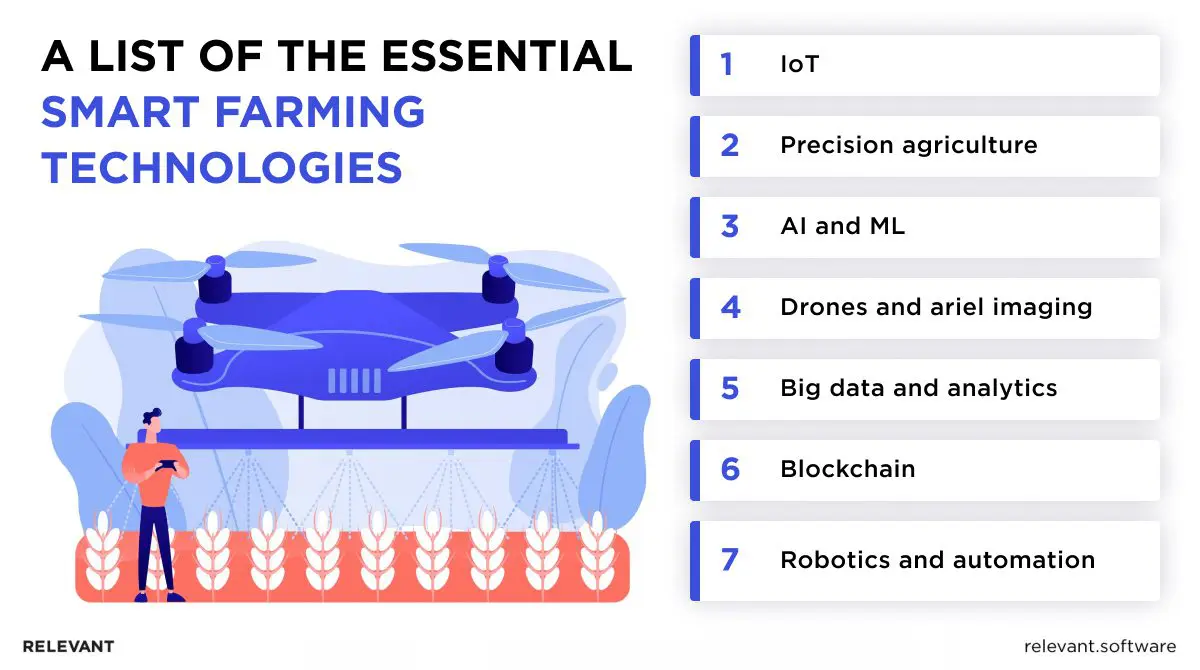
Internet of Things (IoT)
The Internet of Things (IoT) is a highly popular technology in agriculture because it connects machines, devices, and any equipment equipped with sensors to let companies capture information on their fields and operational conditions. It’s like giving your farm a nervous system, where each device is a sensor feeding back information about the state of the land, crops, or machinery. With IoT for smart farming, companies can make data-driven decisions that greatly reduce costs and increase yields.
There is a myriad of smart devices that allow you to track the most critical parameters of your agribusiness. Below, we review some sensor types and their functions:
- Soil Sensors measure parameters like moisture levels, temperature, nutrient content, and pH, letting farmers optimize irrigation, fertilization, and planting strategies.
- Crop Sensors mounted on drones or tractors can monitor crop health by analyzing factors like chlorophyll content, leaf area, and presence of disease.
- Livestock Sensors: Sensors implanted in animals or worn as collars track vital signs, movement patterns, and even breeding cycles.
If you are interested in this particular smart farming technology, find out more about the top Applications of IoT in Agriculture.
Precision Agriculture
Precision agriculture is the philosophy of using data-driven insights to optimize farm management. Thanks to precision farming solutions, every drop of water, every ounce of fertilizer, and every square foot of land is used to its full potential. With it, growers can apply the right resources at the right time and place, minimizing waste while maximizing output.
Using GPS technology for vehicle and equipment tracking and variable rate technology (VRT) to optimize the distribution of inputs to match crop needs, precision agriculture allows agribusinesses to:
- Map fields with pinpoint accuracy, knowing the exact location and condition of different crop zones.
- Tailor inputs like seeds, water, and fertilizers to each specific area of the field based on real-time data rather than applying them uniformly.
- Reduce costs and environmental impact since fewer resources are wasted on over-application.
- Improve yield predictions using up-to-date data on soil health and crop growth.
Instead of treating your entire farm like one big, homogenous area, it lets you manage it as the diverse, dynamic ecosystem that it really is.
Artificial Intelligence (AI) and Machine Learning (ML)
Probably, the most trending technologies – AI and ML – made a splash in agriculture just as in any other industry. Since smart agriculture solutions depend largely on data, AI with its capabilities to process an overwhelming volume of data in a short period of time, found a natural fit for the agricultural sector. AI and IoT in agriculture help farmers make sense of all the data they collect and extract insights to guide their operations and improve resource consumption. Let’s review a few AI and ML applications in farming.
- Predictive Analytics. AI can analyze historical weather data, crop performance, and soil health to forecast the best planting and harvesting times. With predictive analytics, you can know ahead of time what your yields will look like or how the weather will impact your crops.
- Automated Decision-Making. Machine learning algorithms learn from your farm’s data and then make recommendations about the most optimal water use or the best time to apply pesticides. Over time, the system learns what works best for your specific farm and continuously improves.
- Disease Detection. AI-driven systems can analyze images from drones or cameras to detect plant diseases in their early stages, sometimes before they’re visible to the naked eye.
Drones and Aerial Imaging
Drones have become a valuable asset in modern farming, benefiting in several ways. These flying machines are now a farmer’s eye in the sky, offering a bird’s-eye view of fields that were previously only possible through expensive satellite imaging.
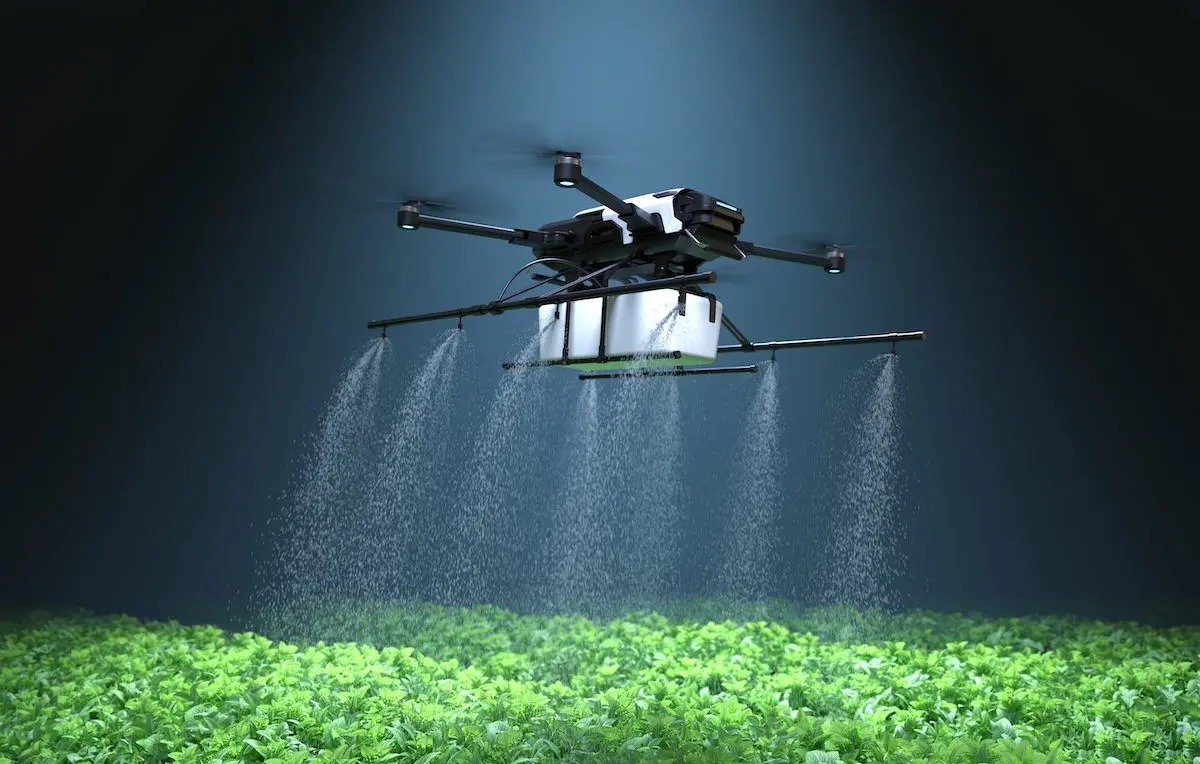
- Field Mapping. Drones can capture highly detailed images of your entire farm in just a few minutes and produce accurate maps that reveal everything from crop growth patterns to problem areas.
- Crop Scouting. Forget walking miles across fields with a clipboard. Drones can do the legwork for you, quickly scanning for signs of pests, disease, or nutrient deficiencies. High-resolution cameras can detect issues that might not be visible to the naked eye, giving farmers a chance to act before problems get out of hand.
- Precision Spraying. Armed with advanced sensors, drones can apply fertilizers or pesticides with pinpoint accuracy, reducing waste and ensuring only the necessary areas are treated.
Big Data and Analytics
Big data is another smart farming technology related to data analytics that helps agribusinesses make wiser decisions regarding their operations and resource management. Put simply, this technology can provide an exhaustive evaluation of soil conditions, for example, by performing a deep analysis of all the relevant information (moisture levels, nutrient content, pH balance, historical crop performance, etc.).
Why may farmers need big data in agriculture at all? Because they can advance their farming practices to produce more crops with less waste. For instance, you can determine the best times to plant or harvest just by letting a big data analytics solution process historical and current weather information. Then, it’s easier to adjust your crop choices or pricing strategies for higher profits if you track market prices and demand. Finally, insights extracted from operational data will help you optimize day-to-day management.
Blockchain for Agricultural Supply Chain
The agricultural supply chain is incredibly complex, with products passing through numerous hands before reaching consumers. While the current system may be prone to fraud and counterfeiting, added transparency and traceability of agricultural product origins offered by blockchain technology can improve the supply chain.
With blockchain, every transaction or movement of a product is recorded on an immutable ledger, meaning it cannot be altered or tampered with. So, anyone – farmers, distributors, retailers, or consumers – can verify the origin and history of a product. Traceability is one more benefit of a blockchain-based smart farming system. In the event of a food safety issue, blockchain allows for quick and precise tracking of products back to their source, which reduces the scope of recalls and ensures faster responses to problems.
Robotics and Automation
The world is moving toward automation to replace more laborious and tedious manual tasks with robots that can do them faster and more efficiently. If we take farming, there is a lot of manual work to automate. Let’s take a look at some exciting case studies:
- Automated Harvesters. Robots like Agrobot are being used to pick delicate fruits like strawberries, using computer vision to identify and harvest only the ripe ones. Cut labor costs and increased speed of berry picking at the optimal time are the results you can expect to achieve.
- Weeding Robots. FarmWise’s Titan robots make weeding smarter by using AI to differentiate between crops and weeds, allowing farmers to reduce the use of herbicides. A chemical-free solution to an age-old problem.
- Planting Robots. PlantTape is an example of other robots that automate the planting process by efficiently transplanting seedlings at high speeds. With such kinds of robots, crops are planted at consistent depths and spacings, which optimizes growth potential.
Benefits of Smart Farming
What’s obvious is that the agricultural industry won’t return to old ways of growing crops and on the contrary, actively embrace smart farming solutions due to the numerous benefits. For example, using field soil sensors can increase your farm’s net profit by just 20%. That said, here’s a list of the main advantages.
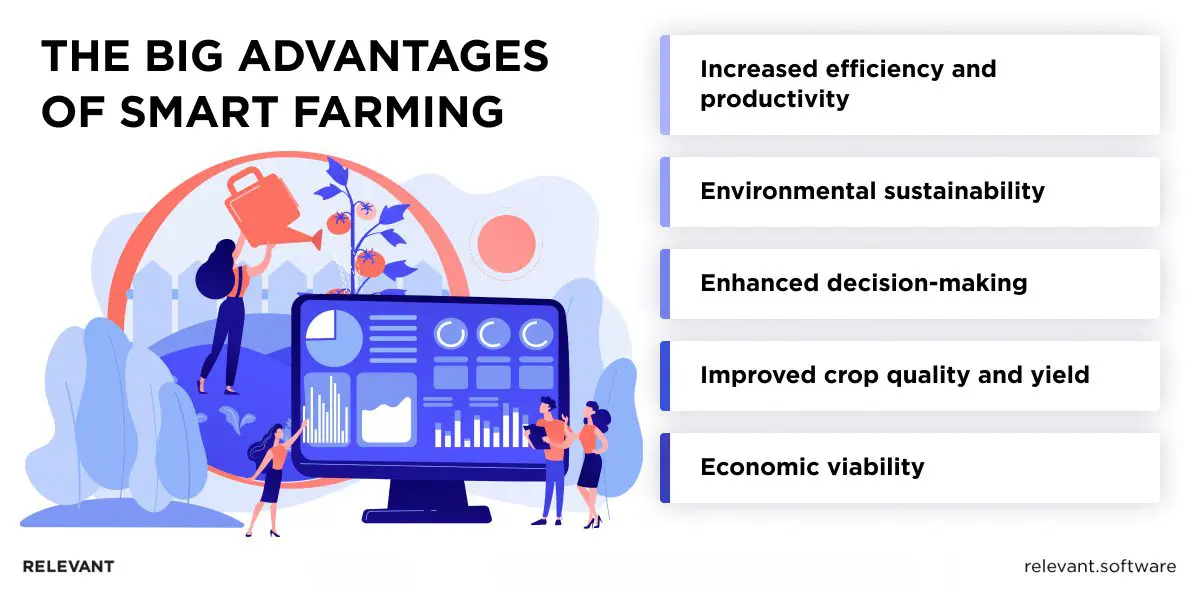
Increased Efficiency and Productivity
Since the smart farming concept is primarily about precision and resource reservation, it lets farmers increase efficiency and boost yields. Instead of spraying an entire field with fertilizer, smart farming technology—like soil sensors and drones—tells you exactly which parts of your field need it and how much. Consequently, no waste, less cost, and healthier crops. See the difference?
For example, smart irrigation systems know when your soil is too dry and will water your crops accordingly. No more guesswork, no more over-watering. You reduce inputs and repurpose them where they matter most or reserve, getting more from your land with fewer resources.
Environmental Sustainability
We’ve all heard about how farming can impact the environment, but smart farming technology flips the script. Precise application of inputs means that pesticides and fertilizers are used only where they’re truly needed, drastically reducing runoff and the contamination of nearby water sources. It’s farming with a smaller environmental footprint.
Smart farming practices can help cut down on carbon emissions as well. Automation and data-driven strategies reduce excessive machinery use, so you benefit from fewer tractor trips across the field and lower fuel consumption. Less waste and optimized energy use keep your fields greener and, at the same time, help you reduce your carbon footprint, too.
Enhanced Decision-Making
Gone are the days when farming was a matter of guesswork or proverbial signs. With a smart farming system, you’ll have up-to-the-minute data on your field and crop conditions, with which you’ll be able to make better, faster decisions. Any parameters critical to your crops, be it soil moisture levels, weather forecasts, or crop growth rates, can be analyzed immediately so you can adjust your strategies on the fly.
Is a drought coming? Your irrigation system can adjust automatically. Detecting early signs of crop disease? You can apply targeted treatments before it spreads. A smart approach to farming turns it into a science with exact measures and effective solutions that help you achieve better outcomes.
Improved Crop Quality and Yield
Healthy crops are a prerequisite for better yields, and smart agriculture technologies help you grow stronger plants by assessing what they need, when, and how exactly. With the help of sensors and IoT devices, you can monitor soil health and environmental conditions to maintain crops in their optimal environment, which ultimately leads to higher crop quality and larger harvests.
And it’s not just about quantity—smart farming also improves the quality of the crops. Healthier plants are less prone to disease and pests, so they will require fewer chemical treatments and result in more nutritious, market-ready produce. Whether you’re growing for the local market or exporting overseas, smart farming boosts both your yield and the quality of what you’re selling.
Economic Viability
All this smart agriculture technology sounds expensive, and well, yes, it requires upfront investment. Still smart farming is economically viable for small and large-scale farms. How? By cutting down on resource waste, automating repetitive tasks, and boosting yields, the cost savings start to add up quickly. And with lower input costs, higher efficiency, and bigger harvests, a smart farming system offers serious potential for increased profitability.
Even for small farmers, the initial investment can pay off faster than you expect. With less guesswork, fewer mistakes, and more precise resource management, profits grow while expenses shrink. In the long run, smart farming isn’t just smart for your crops—it’s smart for your wallet, too.
Global Examples of Smart Farming
Smart farming has taken root globally, and that’s of little surprise, given the incredible impact it has on productivity and sustainability. As farms, big and small, increasingly employ data-driven solutions, the results speak for themselves. We have picked three of the most impactful examples of smart farming technology in action in different countries.
High-tech Greenhouses and Precision Agriculture in the Netherlands
The Netherlands is one of the leading exporters of tulips and vegetables globally despite its small land area. The reason for such success is its adoption of high-tech, precision farming methods. To get the most out of the limited land while acting sustainably, Dutch farmers use a blend of technologies that include automated climate control, LED lighting, smart irrigation systems, GPS, drones, and sensors. Thanks to the smart growing approach, farmers optimize growing conditions year-round, ensuring maximum yield and quality while using significantly less land and water compared to traditional farming methods.
IoT and Smart Farming in India
India, a country with a large agricultural sector, is increasingly embracing smart farming technologies to address challenges such as water scarcity and soil degradation. Initiatives like the National Agricultural Market (e-NAM) and the National Digital Agriculture Mission (NDAM) are promoting the use of digital tools and data analytics to improve agricultural productivity and market access. This has motivated Indian growers to use drones and remote sensors to address the country’s major concern – water scarcity and consistently produce healthy plants.
Remotely Controlled Irrigation to Monitor Vine Health in California
In sun-drenched California, a winery turned to technology to quench its thirst for efficiency. They implemented cloud-based tools that collect and process satellite imagery, weather forecasts, and sensor data to create a unique watering system for each vine. By covering the precise water needs of each vine, the winery achieved a 26% increase in yield and a 16% reduction in water usage.
You don’t need to have a degree to see that smart farming is a sustainable and more efficient way to go for farmers who face increasing costs and declining profitability. We won’t exaggerate if we say that the future belongs to smart agriculture, and a number of cases prove its viability.
Our AgriTech Case Study
We know what we are talking about when we say that farming technology solutions redefine agricultural methods farmers have been using for centuries. Agriculture software development is one of our main specialties, and we help agribusinesses like yours improve their bottom lines with the help of technology.
Barcode Scanning App for Accelerated Berry Picking
Wish Farms, a Florida berry giant, turned to Relevant with the need to modernize their berry-picking process. They wanted to build a solution to make tracking and managing their harvest more efficient, even under harsh weather conditions, be it heavy rain or glaring sun.

We built a React Native app that allows field workers to scan barcodes to track berry collection in real-time. It was designed with usability in mind—high-contrast buttons for easy navigation, even with gloves on, and a training mode for new workers to practice without affecting data. Simple at first sight, a barcode system that we built can process more than thousands of codes each day. With increased traceability of the berry-picking process, Wish Farms has gained greater visibility into operations and reduced errors.
How can Relevant Help Grow your Farming Business?
Smart farming is a quantum leap for agriculture as it brings predictability and certainty to a field that has long relied on intuition and tradition. So stop thinking that high-tech solutions are only for big corporations or distant futures. These tools are more affordable than you might suppose, and your investment will quickly pay off with the massive value they deliver.
If you want to succeed in today’s agriculture industry, there’s only one way – find a reliable technology partner who will understand your unique needs and help you implement a smart farming system tailored to your operations. Relevant experts with hands-on experience building custom agriculture software for businesses of all sizes can be perfect candidates. We have collaborated with dozens of organizations worldwide, using cloud computing, satellite monitoring, IoT, big data, and other innovations to help them thrive. Contact us to grow your farming business smartly.



